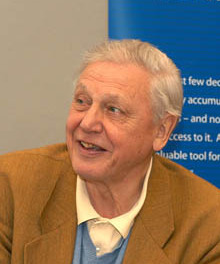
The roc is an enormous legendary bird of prey in the popular mythology of the Middle East.

Sir David Frederick Attenborough OM GCMG CH CVO CBE is an English broadcaster, natural historian and author. He is best known for writing and presenting, in conjunction with the BBC Natural History Unit, the nine natural history documentary series forming the Life collection, a comprehensive survey of animal and plant life on Earth.

The Bronx Zoo is a zoo within Bronx Park in the Bronx, New York. It is one of the largest zoos in the United States by area and is the largest metropolitan zoo in the United States by area, comprising 265 acres (107 ha) of park lands and naturalistic habitats separated by the Bronx River. On average, the zoo has 2.15 million visitors each year as of 2009. The zoo's original permanent buildings, known as Astor Court, were designed as a series of Beaux-Arts pavilions grouped around the large circular sea lion pool. The Rainey Memorial Gates were designed by sculptor Paul Manship in 1934 and listed on the National Register of Historic Places in 1972.

Wildlife traditionally refers to undomesticated animal species, but has come to include all organisms that grow or live wild in an area without being introduced by humans. Wildlife was also synonymous to game: those birds and mammals that were hunted for sport. Wildlife can be found in all ecosystems. Deserts, forests, rainforests, plains, grasslands, and other areas, including the most developed urban areas, all have distinct forms of wildlife. While the term in popular culture usually refers to animals that are untouched by human factors, most scientists agree that much wildlife is affected by human activities. Some wildlife threaten human safety, health, property, and quality of life. However, many wild animals, even the dangerous ones, have value to human beings. This value might be economic, educational, or emotional in nature.
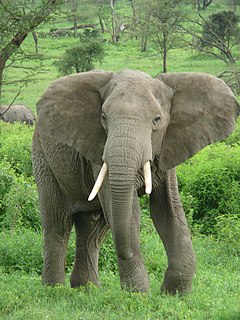
In terrestrial zoology, the megafauna comprises the large or giant animals of an area, habitat, or geological period, extinct and/or extant. The most common thresholds used are weight over 45 kilograms (100 lb) or over a tonne, 1,000 kilograms (2,205 lb). The first of these include many species not popularly thought of as overly large, and being the only few large animals left in a given range/area, such as white-tailed deer, thomson's gazelle, and red kangaroo. In practice, the most common usage encountered in academic and popular writing describes land mammals roughly larger than a human that are not (solely) domesticated. The term is especially associated with the Pleistocene megafauna – the land animals often larger than modern counterparts considered archetypical of the last ice age, such as mammoths, the majority of which in northern Eurasia, the Americas and Australia became extinct within the last forty thousand years. Among living animals, the term megafauna is most commonly used for the largest extant terrestrial mammals, which includes elephants, giraffes, hippopotamuses, rhinoceroses, and large bovines. Of these five categories of large herbivores, only bovines are presently found outside of Africa and southern Asia, but all the others were formerly more wide-ranging, with their ranges and populations continually shrinking and decreasing over time. Wild equines are another example of megafauna, but their current ranges are largely restricted to the old world, specifically Africa and Asia. Megafaunal species may be categorized according to their dietary type: megaherbivores, megacarnivores, and, more rarely, megaomnivores. Megafauna are also categorized by the order of animals that they belong to, which are mammals, birds, reptiles, amphibians, fish, and invertebrates.
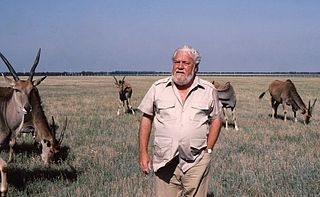
Gerald Malcolm Durrell, was a British naturalist, writer, zookeeper, conservationist, and television presenter. He founded the Durrell Wildlife Conservation Trust and the Jersey Zoo on the Channel Island of Jersey in 1959. He wrote approximately forty books, mainly about his life as an animal collector and enthusiast, the most famous being My Family and Other Animals (1956). Those memoirs of his family's years living in Greece were adapted into two television series and one television film. He was the youngest brother of novelist Lawrence Durrell.
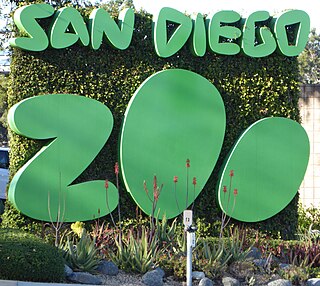
The San Diego Zoo is a zoo in Balboa Park, San Diego, California, housing over 12,000 animals of more than 650 species and subspecies on 100 acres (40 ha) of Balboa Park leased from the City of San Diego. Its parent organization, San Diego Zoo Wildlife Alliance, is a private nonprofit conservation organization, and has one of the largest zoological membership associations in the world, with more than 250,000 member households and 130,000 child memberships, representing more than a half million people.

Elephant birds are members of the extinct ratite family Aepyornithidae, made up of large to enormous flightless birds that once lived on the island of Madagascar. They became extinct, perhaps around 1000–1200 AD, probably as a result of human activity. Elephant birds comprised the genera Mullerornis, Vorombe and Aepyornis. While they were in close geographical proximity to the ostrich, their closest living relatives are kiwi, suggesting that ratites did not diversify by vicariance during the breakup of Gondwana but instead evolved from ancestors that dispersed more recently by flying.

Chester Zoo is a zoo at Upton-by-Chester, Cheshire, England. Chester Zoo was opened in 1931 by George Mottershead and his family. It is one of the UK's largest zoos at 51 hectares. The zoo has a total land holding of approximately 160 hectares.

Aepyornis is a genus of aepyornithid, one of three genera of ratite birds endemic to Madagascar until their extinction sometime around AD 1000. The species A. maximus weighed up to 540 kilograms (1,200 lb), and until recently was regarded as the largest known bird of all time. However, in 2018 the largest aepyornithid specimens, weighing up to 730 kilograms (1,600 lb), were moved to the related genus Vorombe. Its closest living relative is the New Zealand Kiwi.

A nature documentary or wildlife documentary is a genre of documentary film or series about animals, plants, or other non-human living creatures, usually concentrating on video taken in their natural habitat but also often including footage of trained and captive animals. Sometimes they are about wildlife or ecosystems in relationship to human beings. Such programmes are most frequently made for television, particularly for public broadcasting channels, but some are also made for the cinema medium. The proliferation of this genre occurred almost simultaneously alongside the production of similar television series.
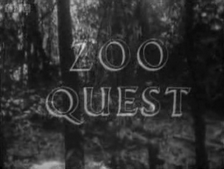
Zoo Quest is a series of multi-part nature documentaries broadcast on the BBC Television Service between 1954 and 1963. It was the first major programme to feature David Attenborough.

Paignton Zoo is a zoo in Paignton, Devon, England. The zoo is part of South West Environmental Parks Ltd which is owned by Wild Planet Trust, formerly known as the Whitley Wildlife Conservation Trust (WWCT). Wild Planet Trust also ran the now closed Living Coasts in Torquay, Devon. They also run Newquay Zoo in Newquay, Cornwall. All three are registered charities.

The composition of Madagascar's wildlife reflects the fact that the island has been isolated for about 88 million years. The prehistoric breakup of the supercontinent Gondwana separated the Madagascar-Antarctica-India landmass from the Africa-South America landmass around 135 million years ago. Madagascar later split from India about 88 million years ago, allowing plants and animals on the island to evolve in relative isolation.

Frozen Planet is a 2011 British nature documentary series, co-produced by the BBC and The Open University. It was filmed by the BBC Natural History Unit. The production team, which includes executive producer Alastair Fothergill and series producer Vanessa Berlowitz, were previously responsible for the award-winning series The Blue Planet (2001) and Planet Earth (2006), and Frozen Planet is billed as a sequel of sorts. David Attenborough returns as narrator. It is distributed under licence by the BBC in other countries, Discovery Channel for North America, ZDF for Germany, Antena 3 for Spain and Skai TV for Greece.

Last Chance to See is a wildlife documentary first broadcast on BBC Two in the United Kingdom during September and October 2009. The series is a follow-up of the 1989 radio series, also called Last Chance to See, in which Douglas Adams and Mark Carwardine set out to find endangered animals. In this updated television version, produced for the BBC, Stephen Fry and Carwardine revisit the animals originally featured to see how they're getting on almost 20 years later.

Madagascar is a British nature documentary series, first broadcast on BBC Two and BBC HD in February 2011. Produced by the BBC Natural History Unit and Animal Planet and narrated by David Attenborough, the three-part series focuses on the landscape and wildlife of the island of Madagascar in the Indian Ocean. Attenborough also appears briefly on camera at the beginning and end of the series. Each episode is followed by a ten-minute Madagascar Diaries segment, illustrating the techniques used to film a particular subject.
Ocean Giants is a 2011 British nature documentary series narrated by actor Stephen Fry. The series is a production of the BBC Natural History Unit, and premiered on 14 August 2011. The documentaries focus on the life of dolphins and whales. The series includes film crew members who worked on the series Planet Earth. The cameramen featured in the show are Doug Allen, a winner of four Emmys and four BAFTAs for his work on filming marine mammals, and Didier Noirot, known for working with marine conservationist Jacques Cousteau.
Attenborough: 60 Years in the Wild is a three-part BBC documentary series chronicling the 60 years career making wildlife programmes of Sir David Attenborough. The first hour-long programme, titled "Life on Camera" was broadcast on Friday 16 November 2012 on BBC Two at 9pm. The second part, "Understanding the Natural World" and third and final part, "Our Fragile Planet" were broadcast on following Fridays, 23 and 30 November 2012.
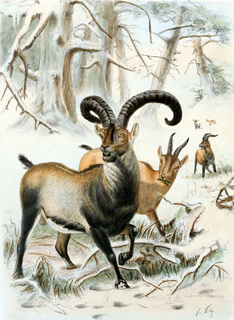
De-extinction is the process of generating an organism that either resembles or is an extinct species. There are several ways to carry out the process of de-extinction. Cloning is the most widely proposed method, although genome editing and selective breeding have also been considered. Similar techniques have been applied to certain endangered species, in hopes to boost their genetic diversity. The only method of the three that would provide an animal with the same genetic identity is cloning. There are both pros and cons to the process of de-extinction ranging from technological advancements to ethical issues.
